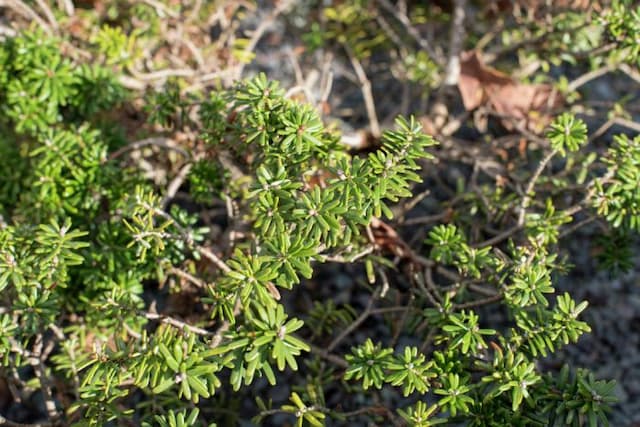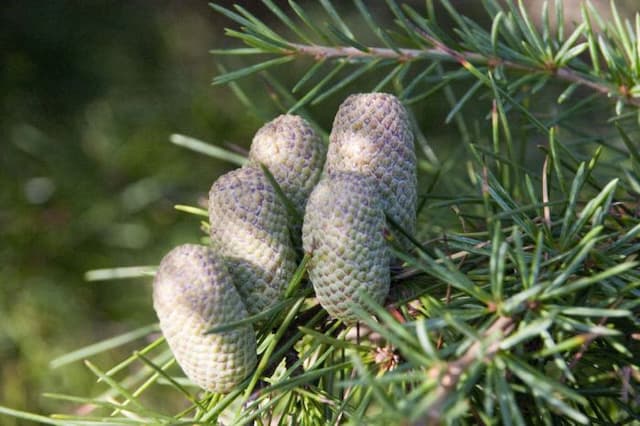Pitch pine Pinus rigida

ABOUT
P. rigida is a large tree with a conical or oval outline, becoming irregular with age, and fissured, dark grey bark. The dark, grey-green needles are thick and stiff, around 10cm long and borne in threes. Yellow-brown cones, 3-9cm long, often persist for several years
About this plant
 Names
NamesFamily
Pinaceae
Synonyms
Pitch Pine, Hard Pine, Northern Pitch Pine, Yellow Pine
Common names
Pinus rigida.
 Characteristics
CharacteristicsLife cycle
Perennials
Foliage type
Evergreen
Color of leaves
Green
Height
40 feet (12 meters)
Spread
20 feet (6 meters)
Plant type
Tree
Hardiness zones
4
Native area
North America
Benefits
 General Benefits
General Benefits- Erosion Control: Pinus rigida, commonly known as pitch pine, has a deep root system that helps stabilize the soil and prevent erosion.
- Habitat for Wildlife: Provides shelter and nesting sites for a variety of birds and small mammals.
- Aesthetic Value: Offers a rugged, picturesque appearance, often used in landscape design for its unique form and texture.
- Reforestation and Land Rehabilitation: Used in reforestation efforts on degraded land, as it is adaptable to a range of harsh conditions.
- Timber and Wood Products: Wood is utilized for construction, fuel, and making tar and pitch.
- Shade and Shelter: The dense canopy offers shade and protection from the elements for the underlying ground, helping to moderate temperatures.
- Food Source: Cones and seeds are eaten by various wildlife species, including birds like the crossbills and small mammals.
 Medical Properties
Medical Properties- Antiseptic: The resin of Pinus rigida is traditionally used for its antiseptic properties.
- Expectorant: The pine needles may be used in herbal teas as an expectorant for coughs.
- Anti-inflammatory: Components of the tree may have anti-inflammatory effects.
- Wound healing: The resin and sap of Pinus rigida have been used in folk medicine to promote wound healing.
 Air-purifying Qualities
Air-purifying QualitiesThis plant is not specifically known for air purifying qualities.
 Other Uses
Other Uses- Pinus rigida, commonly known as pitch pine, has historically been used for shipbuilding, particularly its resin, which could seal the wooden seams against water.
- The wood of pitch pine trees is often used for making railroad ties due to its high resin content that gives it resistance to decay and termites.
- Due to its toughness and resilience, pitch pine wood is sometimes employed in the construction of heavy-duty flooring for warehouses and factories.
- Pitch pine is also used in the creation of rustic furniture, as its knots and irregularities can add character to the pieces.
- The tree’s resin, once processed into turpentine, has been used as a component in varnishes and paints.
- In landscaping, pitch pine is occasionally planted as a windbreak or for erosion control because of its extensive root system and adaptability to poor soil conditions.
- Artists may use pitch pine to create charcoal for sketching and drawing, as it creates a rich dark line.
- The bark of pitch pine can be utilized as a natural mulch for gardens, helping to retain soil moisture and deter weeds.
- Pitch pine cones can be used in decorative crafts, such as wreaths and centerpieces, as they have a unique, rugged appearance.
- When dried and treated, pitch pine needles are sometimes crafted into traditional basketry and other woven goods.
Interesting Facts
 Feng Shui
Feng ShuiThe Pitch Pine is not used in Feng Shui practice.
 Zodiac Sign Compitability
Zodiac Sign CompitabilityThe Pitch Pine is not used in astrology practice.
 Plant Symbolism
Plant Symbolism- Resilience: Pinus rigida, commonly known as pitch pine, is known for its ability to survive in poor soil conditions and recover quickly from damage, making it a symbol of resilience and persistence.
- Adaptability: Pitch pine's capability to thrive in harsh environments represents adaptability and the capacity to adjust to changing circumstances.
- Endurance: The pitch pine, with its sturdy nature and longevity, embodies endurance and the ability to withstand challenges over time.
- Renewal: Pitch pine has a remarkable regenerative property; it can sprout new growth from its stump if the top is destroyed, symbolizing renewal and new beginnings.
- Strength: The wood of pitch pine is strong and was historically used for construction and shipbuilding, making it a symbol of strength and sturdiness.
 Water
WaterThe Pitch Pine should be watered regularly during its first growing season to establish a deep root system, and then as needed depending on the weather and soil moisture. In general, watering once a week with about 1 to 1.5 gallons of water is sufficient for an established tree, but young or container-grown trees may require more frequent watering. It's important to provide deep watering to encourage root development, rather than shallow sprinklings, which may not reach the deeper roots. During dry spells or in particularly hot climates, increase the amount slightly. Always check the soil moisture level to ensure it is not waterlogged or bone dry, as both conditions can be harmful to the Pitch Pine.
 Light
LightThe Pitch Pine thrives in full sunlight, which means the plant prefers to be in a spot where it can receive at least six hours of direct, unfiltered sunlight each day. The best location for the Pitch Pine is in an open space, away from taller structures or trees that might shade it, to ensure the tree receives adequate light for optimal growth and cone production.
 Temperature
TemperatureThe Pitch Pine is adaptable to a wide range of temperatures, but it grows best in conditions that mimic its native environment. It can survive minimum temperatures down to at least -30 degrees Fahrenheit, but the ideal temperature range for the plant is between 60 and 75 degrees Fahrenheit. The Pitch Pine is generally hardy and can tolerate cold winters, making it suitable for various temperate regions.
 Pruning
PruningPrune the Pitch Pine to remove dead or damaged branches and to maintain its natural shape, which is typically only necessary every few years. The best time for pruning is late winter to early spring, before the new growth starts. Pruning can also be done to improve air circulation or to remove limbs that may pose a hazard. However, avoid excessive pruning, as the Pitch Pine may not require it as much as other ornamental trees.
 Cleaning
CleaningNot needed
 Soil
SoilPitch Pine thrives in well-draining, sandy or rocky soil with an acidic pH between 4.5 to 5.5. A mix of sand, organic matter, and garden loam is ideal for providing the necessary conditions.
 Repotting
RepottingPitch Pine should be repotted every 2 to 3 years to refresh the soil and accommodate root growth, although mature trees may require less frequent repotting.
 Humidity & Misting
Humidity & MistingThe best humidity conditions for Pitch Pine are low to moderate; it is tolerant of a range of humidity levels and does not require high humidity to thrive.
 Suitable locations
Suitable locationsIndoor
Ensure ample light and air flow; don't overwater.
Outdoor
Full sun, well-draining soil; tolerant of poor conditions.
Hardiness zone
4-7 USDA
 Life cycle
Life cyclePinus rigida, commonly known as pitch pine, begins its life cycle as a seed, often requiring the heat from a fire to break dormancy and germinate. Upon germination, a seedling emerges, developing a taproot and growing needles in fascicles of three, which is characteristic of this species. As a juvenile, the pitch pine invests energy in establishing a strong root system and increasing its height and girth. In maturity, which can occur at around 10-20 years, the tree produces cones containing seeds; these cones often remain closed until exposed to the high temperatures of a forest fire. Throughout its adult life, the pitch pine can endure and even thrive in poor soil conditions and fire-prone environments, often resprouting needles and branches after damage. The pitch pine may live for two centuries or more, with senescence marked by a reduction in growth and reproductive capability before eventually succumbing to environmental pressures, pests, or diseases.
 Propogation
PropogationPropogation time
Spring to Summer
The most popular method of propagation for the Pitch Pine, which is the common name for Pinus rigida, is through seed sowing. To propagate Pitch Pines by seed, cones should ideally be collected in the fall once they have turned a rich brown color, indicating maturity, but before they have opened to disperse their seeds. The seeds require a period of cold stratification to break dormancy, which involves mixing the seeds with moist sand and refrigerating them at a temperature of 34 to 40 degrees Fahrenheit (1 to 4 degrees Celsius) for about 60 to 90 days. After stratification, seeds are sown in the spring, either directly in the field or in containers. They should be placed in well-drained soil and covered with a light layer of soil about a quarter of an inch thick (approx. 6 millimeters). A sunny location is ideal, as Pitch Pines require full sun for optimal growth. Seedlings typically emerge after a few weeks and should be kept well-watered during their first growing season.









